选择性必修二 Unit 5 First Aid - Project(31张PPT)
文档属性
| 名称 | 选择性必修二 Unit 5 First Aid - Project(31张PPT) |  | |
| 格式 | pptx | ||
| 文件大小 | 8.5MB | ||
| 资源类型 | 试卷 | ||
| 版本资源 | 人教版(2019) | ||
| 科目 | 英语 | ||
| 更新时间 | 2022-02-05 10:37:28 | ||
图片预览

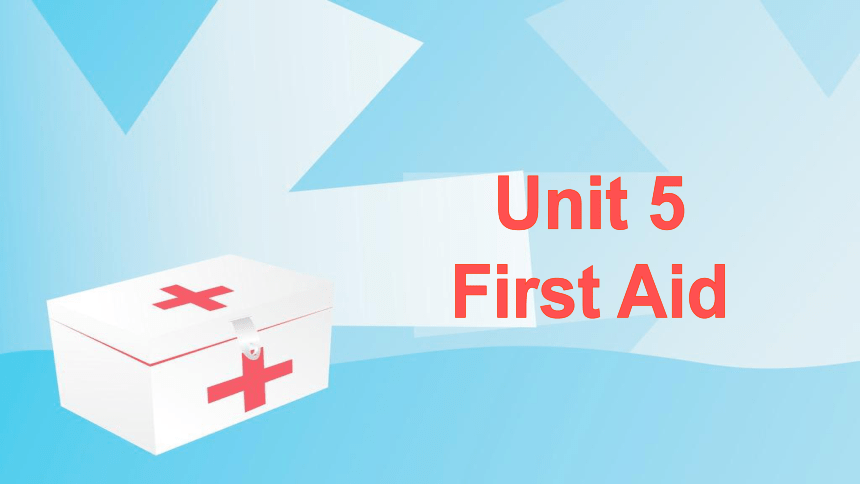
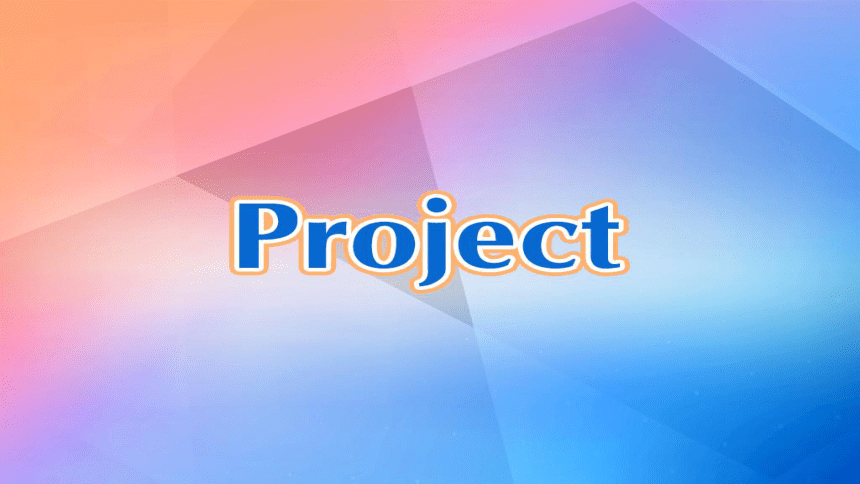
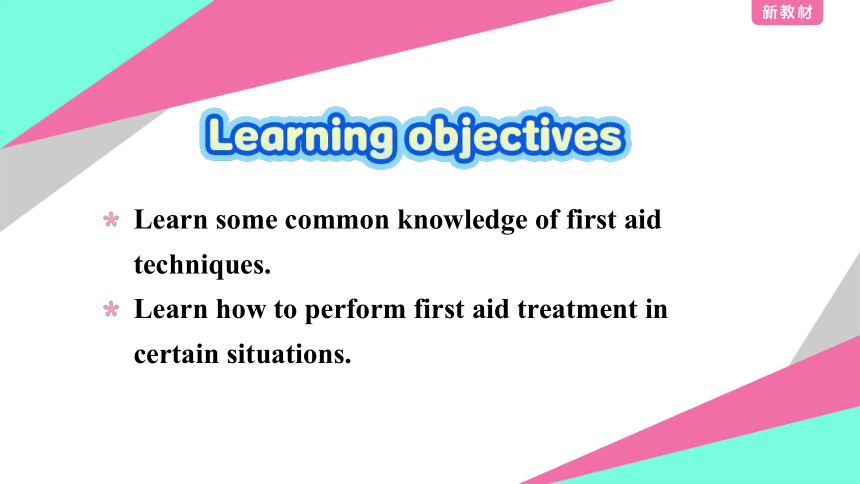
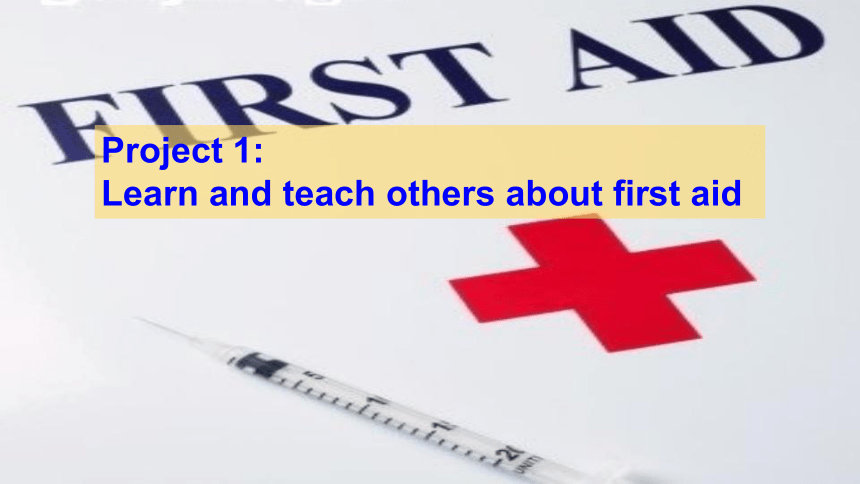
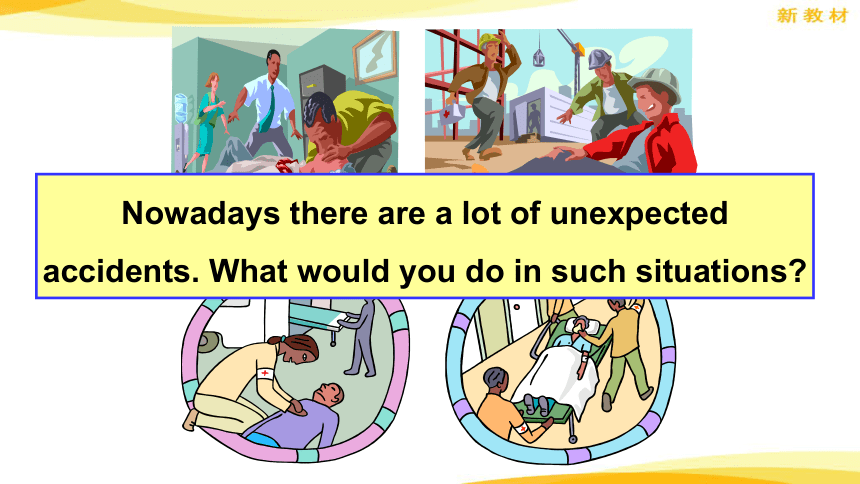
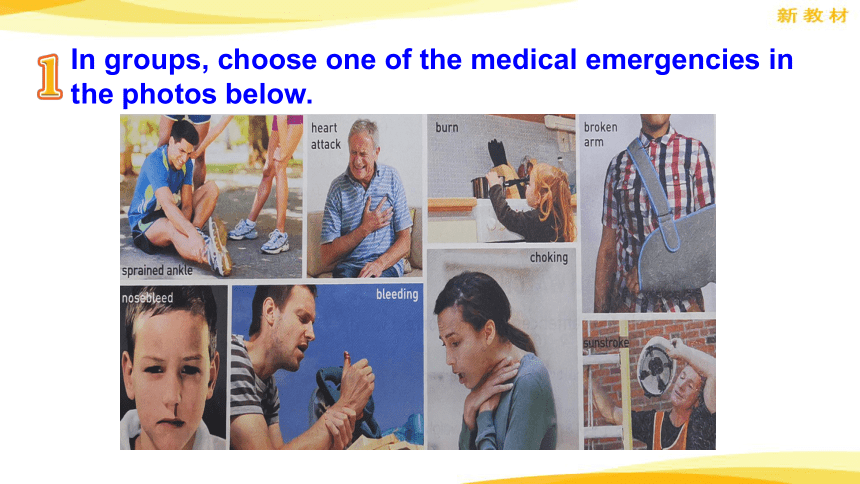
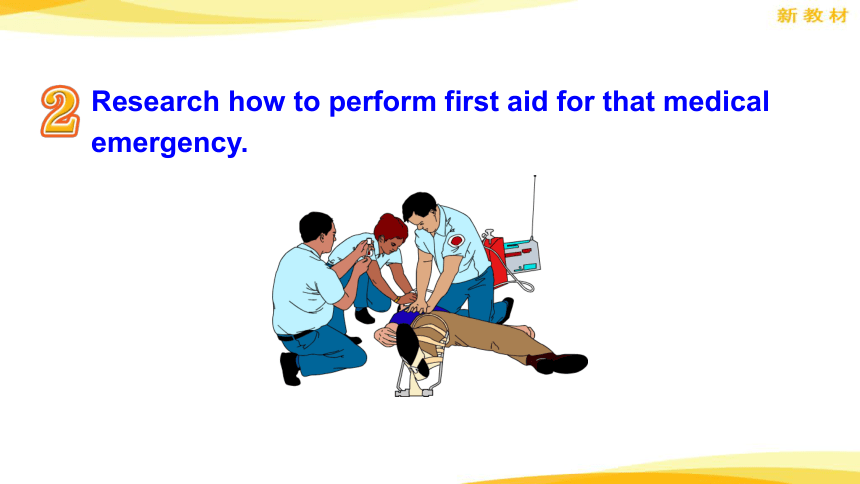

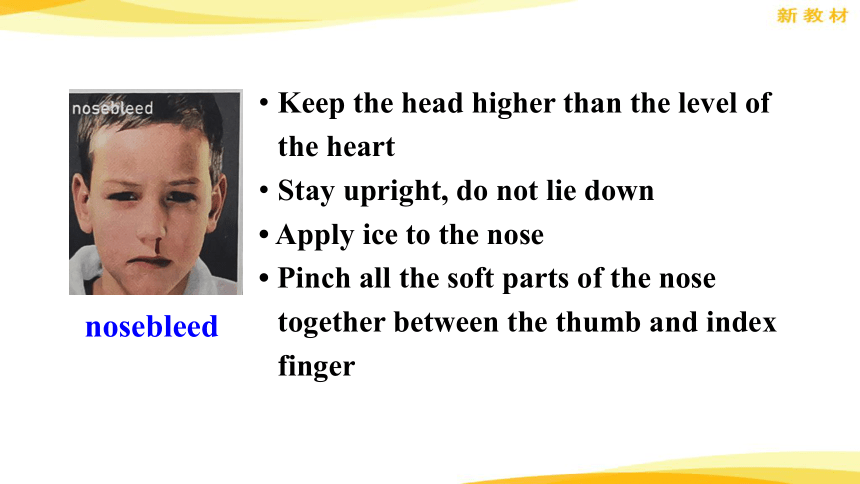


文档简介
(共31张PPT)
Unit 5
Unit 5
First Aid
Learn some common knowledge of first aid techniques.
Learn how to perform first aid treatment in certain situations.
Project 1:
Learn and teach others about first aid
Nowadays there are a lot of unexpected accidents. What would you do in such situations
In groups, choose one of the medical emergencies in the photos below.
Research how to perform first aid for that medical emergency.
Have the victim sit down and elevate the foot.
Put an ice pack on the ankle to reduce the swelling.
Put a firm bandage around the foot and ankle.
sprained ankle
Keep the head higher than the level of the heart
Stay upright, do not lie down
Apply ice to the nose
Pinch all the soft parts of the nose together between the thumb and index finger
nosebleed
Put a bandage on the wound and apply pressure to reduce the bleeding.
bleeding
If the person can cough, don’t do anything.
If he/she can’t cough and is turning blue in the face, hit him/her between the shoulder blades (肩胛骨) with the flat of the hand three or four times.
chocking
Do not move the broken bone if possible. Do not move the victim.
Support the broken arm in the most comfortable position.
Keep the arm still using a sling or get the victim to support the broken arm with the other arm.
Get medical help immediately.
broken arm
1. Check to see if he is breathing.
2. Try to start his breathing.
Some more situations
Press a hand on his chest many times.
Use the mouth-to-mouth method.
Lay him on his back, close his nose with your fingers and breathe into his mouth. Repeat this as often as necessary.
Learn how to swim.
Swim with a life-buoy.
Never swim alone.
Don’t swim in dangerous waters.
Call for a doctor or an ambulance.
Never pull her out of the car.
Find enough people to lift the car safely and take her to hospital at once.
Look at both sides when crossing the street.
Call 119 first and tell them the exact address on the phone.
Call 120 to ask for an ambulance if someone is badly burnt.
Cool the area of skin and put a piece of dry clean cloth over the area of skin.
Keep calm and find your way out quickly, using the escape route exit.
Try to sound the fire alarm.
Don’t open the door if the door is hot or if you see smoke coming under the door.
Stand in front of a open window and shout for help. Try to cover your mouth with a wet towel.
Go to the hospital at once.
Never pull it out of the cut.
For not serious cuts, wash the area of cut, dry it and cover it with a bandage or a piece of dry and clean cloth.
Important numbers
120
119
110
Emergency medical service
Fire department
Police department
Make an instruction leaflet for giving first aid for that emergency. Include illustrations for any points that are not clear.
Combine all the leaflets to make a first-aid manual for your class.
23
Project 2:
Make your own first-aid kit
With a partner, research what should be included in a first-aid kit, how the items in the first-aid kit should be used, and in which emergencies they should be used.
Collect the items and put them in a box or container that is easy to store and find. In most cases, the items for a first-aid kit can be bought cheaply at a pharmacy.
Draw up an information sheet to go in the first-aid kit. It should include emergency phone numbers, a list of the items, and an explanation of how to use the items. Use the table below to help you.
Emergency phone numbers Police: 110; Fire: 119 Ambulance: 120
Items When to use How to use
1 hydrogen peroxide or alcohol; gauze or cotton balls an open wound Use gauze or cotton balls to wipe the liquid over a wound in order to clean it.
2 bandages a small wound Cover a wound with a bandage.
3 antibiotic cream a small wound Apply it to a wound to stop infection.
Items When to use How to use
4 gauze; medical tape; scissors a large wound Cover a wound with gauze and then tape it securely to the body. If a wound is bleeding heavily, use gauze to press down on it until bleeding stops or help arrives.
5 plastic gloves when dealing with blood or dangerous fluids
Put on gloves before offering first aid.
Items When to use How to use
6 aspirin heart attack Give one pill to someone suffering a mild heart attack.
7 pain reliever pain or fever Use it as directed on the bottle.
8 elastic bandages sprains or broken bones For an ankle sprain, wrap a bandage securely around the ankle for support and to hold down swelling. For a break, use a bandage to secure a splint to the arm or leg.
Items When to use How to use
9 First-aid manual to gain information on how to treat an injured person at the scene Refer to the contents page to find the relevant information for the situation.
Present your first-aid kit to the class.
Introduce and explain the use of each
item.
Unit 5
Unit 5
First Aid
Learn some common knowledge of first aid techniques.
Learn how to perform first aid treatment in certain situations.
Project 1:
Learn and teach others about first aid
Nowadays there are a lot of unexpected accidents. What would you do in such situations
In groups, choose one of the medical emergencies in the photos below.
Research how to perform first aid for that medical emergency.
Have the victim sit down and elevate the foot.
Put an ice pack on the ankle to reduce the swelling.
Put a firm bandage around the foot and ankle.
sprained ankle
Keep the head higher than the level of the heart
Stay upright, do not lie down
Apply ice to the nose
Pinch all the soft parts of the nose together between the thumb and index finger
nosebleed
Put a bandage on the wound and apply pressure to reduce the bleeding.
bleeding
If the person can cough, don’t do anything.
If he/she can’t cough and is turning blue in the face, hit him/her between the shoulder blades (肩胛骨) with the flat of the hand three or four times.
chocking
Do not move the broken bone if possible. Do not move the victim.
Support the broken arm in the most comfortable position.
Keep the arm still using a sling or get the victim to support the broken arm with the other arm.
Get medical help immediately.
broken arm
1. Check to see if he is breathing.
2. Try to start his breathing.
Some more situations
Press a hand on his chest many times.
Use the mouth-to-mouth method.
Lay him on his back, close his nose with your fingers and breathe into his mouth. Repeat this as often as necessary.
Learn how to swim.
Swim with a life-buoy.
Never swim alone.
Don’t swim in dangerous waters.
Call for a doctor or an ambulance.
Never pull her out of the car.
Find enough people to lift the car safely and take her to hospital at once.
Look at both sides when crossing the street.
Call 119 first and tell them the exact address on the phone.
Call 120 to ask for an ambulance if someone is badly burnt.
Cool the area of skin and put a piece of dry clean cloth over the area of skin.
Keep calm and find your way out quickly, using the escape route exit.
Try to sound the fire alarm.
Don’t open the door if the door is hot or if you see smoke coming under the door.
Stand in front of a open window and shout for help. Try to cover your mouth with a wet towel.
Go to the hospital at once.
Never pull it out of the cut.
For not serious cuts, wash the area of cut, dry it and cover it with a bandage or a piece of dry and clean cloth.
Important numbers
120
119
110
Emergency medical service
Fire department
Police department
Make an instruction leaflet for giving first aid for that emergency. Include illustrations for any points that are not clear.
Combine all the leaflets to make a first-aid manual for your class.
23
Project 2:
Make your own first-aid kit
With a partner, research what should be included in a first-aid kit, how the items in the first-aid kit should be used, and in which emergencies they should be used.
Collect the items and put them in a box or container that is easy to store and find. In most cases, the items for a first-aid kit can be bought cheaply at a pharmacy.
Draw up an information sheet to go in the first-aid kit. It should include emergency phone numbers, a list of the items, and an explanation of how to use the items. Use the table below to help you.
Emergency phone numbers Police: 110; Fire: 119 Ambulance: 120
Items When to use How to use
1 hydrogen peroxide or alcohol; gauze or cotton balls an open wound Use gauze or cotton balls to wipe the liquid over a wound in order to clean it.
2 bandages a small wound Cover a wound with a bandage.
3 antibiotic cream a small wound Apply it to a wound to stop infection.
Items When to use How to use
4 gauze; medical tape; scissors a large wound Cover a wound with gauze and then tape it securely to the body. If a wound is bleeding heavily, use gauze to press down on it until bleeding stops or help arrives.
5 plastic gloves when dealing with blood or dangerous fluids
Put on gloves before offering first aid.
Items When to use How to use
6 aspirin heart attack Give one pill to someone suffering a mild heart attack.
7 pain reliever pain or fever Use it as directed on the bottle.
8 elastic bandages sprains or broken bones For an ankle sprain, wrap a bandage securely around the ankle for support and to hold down swelling. For a break, use a bandage to secure a splint to the arm or leg.
Items When to use How to use
9 First-aid manual to gain information on how to treat an injured person at the scene Refer to the contents page to find the relevant information for the situation.
Present your first-aid kit to the class.
Introduce and explain the use of each
item.
